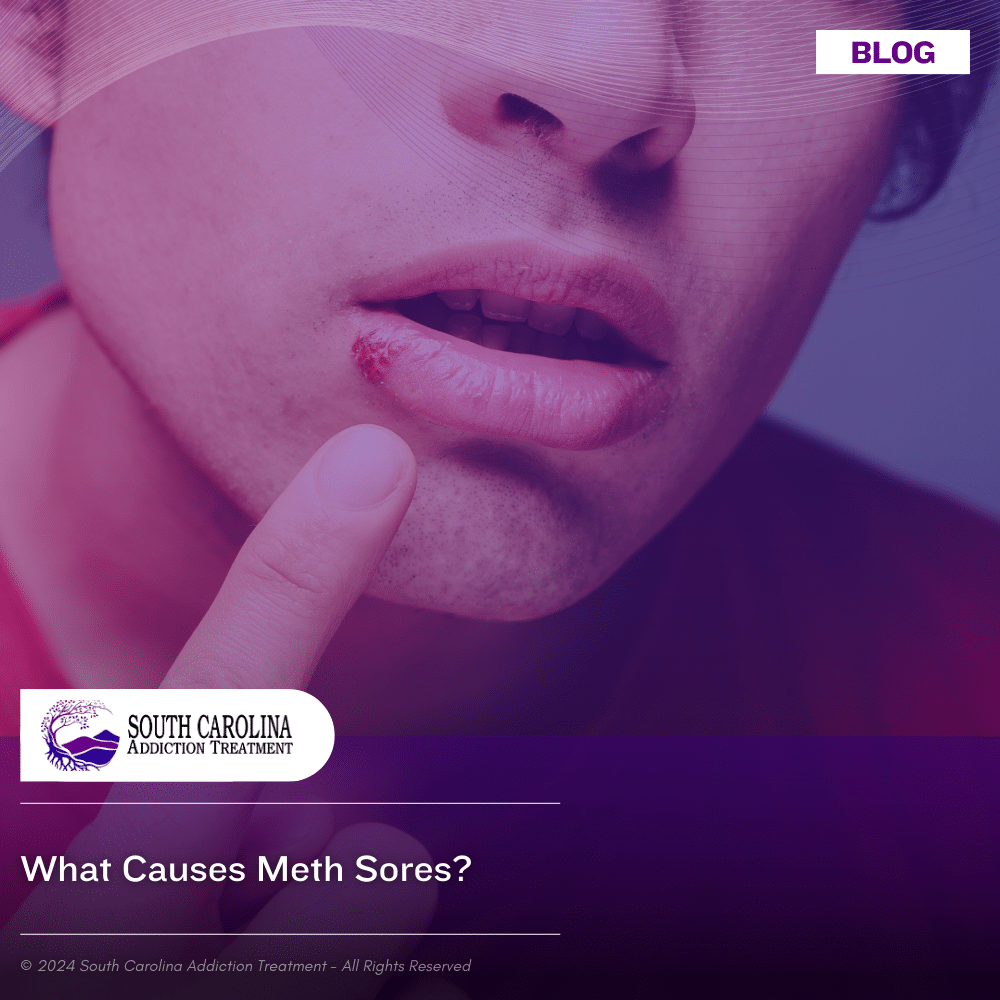What Causes Meth Sores?

Medically Verified: 2/1/24
Medical Reviewer
Chief Editor

All of the information on this page has been reviewed and verified by a certified addiction professional.
Methamphetamine is a powerful, dangerous drug that devastates the lives of people who use it. It’s important to recognize the signs of meth abuse and seek addiction treatment as soon as possible to avoid life-altering consequences.
Meth sores are one sign that a person is using methamphetamine. This guide will outline what meth sores are, what causes them, and how to find the treatment and support you need to stop using meth safely. Reach out to the South Carolina Addiction Treatment staff to explore our meth rehab programs or find the support you need in recovery.
What is Methamphetamine?
Methamphetamine, or meth, is a potent stimulant that increases activity in a person’s central nervous system (CNS). In addition to increased alertness and energy, methamphetamine also causes users to experience a sense of euphoria. It causes the brain to release large amounts of dopamine, a neurotransmitter involved with pleasure and reward. Meth and other drugs that affect the brain’s dopamine levels have the potential to be addictive.
People who abuse methamphetamine are likely to become dependent or addicted to it. Understanding the risk of addiction and recognizing the signs of dependence is essential to people who use meth and their loved ones.
What Are Meth Sores?
Meth abuse takes a toll on a person’s health and appearance. One of the most recognizable effects of meth abuse is the presence of meth sores. Meth sores can look different from person to person. People may have sores that look like scabs, open wounds, burns, or acne on their lips, face, and body.
What Causes Meth Sores?
Many things can cause people who use meth to develop sores and wounds. Here are some of the most common causes of meth sores.
Sweat
Meth is water-soluble and is present in the sweat of people who use methamphetamine. This combination of sweat and meth is highly irritating to the skin and can cause lesions.
Pipe burns
People who use pipes to smoke meth may get irritation, burns, or sores around their mouth, nose, and chin from the excessive heat.
Meth mites and skin picking
Some people who use meth may hallucinate that there are bugs on or under their skin. Users may pick or scratch at their skin to get the imagined bugs out, causing sores and open wounds. This is also known as “skin picking.”
Poor blood flow
Meth constricts users’ blood vessels and prevents blood from reaching the skin’s surface as efficiently. Users may have dry, flaky skin or scaly patches on their arms and face.
Poor immunity
Using meth leads to a weakened immune system that can’t fight infection or heal wounds as quickly. This may affect the body’s ability to heal meth sores that have developed. Bacteria can enter the open sores and cause serious–sometimes life-threatening–complications, including infection and sepsis.
Meth sores are often a clear indicator that a person is using meth. It is very challenging for these sores to heal until the person receives comprehensive treatment to stop using meth.
What Are Other Effects of Methamphetamine Use?
Meth sores are often one of the clearest visual signs of a person abusing meth. But the drug also causes many other short and long-term effects.
Short-term effect
Meth is a powerful stimulant. Some of the short-term effects of meth use include:
- Increased attention and focus
- Less fatigue
- Reduced appetite
- Euphoria or a “high”
- Faster breathing
- Quick or irregular heartbeat
- Increased body temperature
People may experience the effects of methamphetamine for 6 to 12 hours or even longer.
Long-term effects
Heavy or frequent meth use can cause changes in the brain’s structure and ability to function. Over time, meth users may find they cannot feel pleasure except when using meth. Other long-term effects of meth abuse include:
- Psychosis
- Paranoia
- Hallucinations
- Repetitive motions
- Declines in motor skills, thinking, and judgment
- Difficulty concentrating and focusing on a task
- Aggressive or violent behaviors
- Mood swings
- Extreme weight loss
- Severe dental decay
- Memory loss
People who abuse meth are also likely to develop an addiction that requires professional treatment and ongoing support.
Recognizing the Signs of Meth Abuse and Addiction
Methamphetamine is a powerful, addictive stimulant. People who use it for just a short period may quickly develop a physical or psychological dependence on it. Meth addiction typically causes significant changes in a person’s appearance and behaviors. Knowing the signs of meth abuse and addiction is the first step toward getting the treatment you need to stop using meth–or to help someone you love.
Here are some of the most common signs of meth abuse and addiction.
Psychological symptoms
- Mood swings
- Paranoia
- Insomnia
- Psychosis
Physical symptoms
- Dental issues, including severe decay and missing teeth
- Sagging, sallow skin
- Meth sores on face and body
- Weight loss
Behavioral and social signs
- Taking risks while under the influence
- Restlessness and hyperactivity
- Legal problems, such as DUIs, child custody cases, arrests, and incarceration
- Interpersonal problems with friends, family, coworkers, and others
Meth sores are one of the most common ways to identify someone living with meth addiction–and a clear sign that they need treatment and support.
Get Help for Meth Abuse and Addiction Now
Meth abuse can quickly spiral into a life-threatening addiction. Don’t wait another day to find the help you or a loved one needs to stop using meth. Call the admission specialists at South Carolina Addiction Treatment now to learn about our life-changing meth addiction treatment programs or to find support at any stage of your recovery journey.

